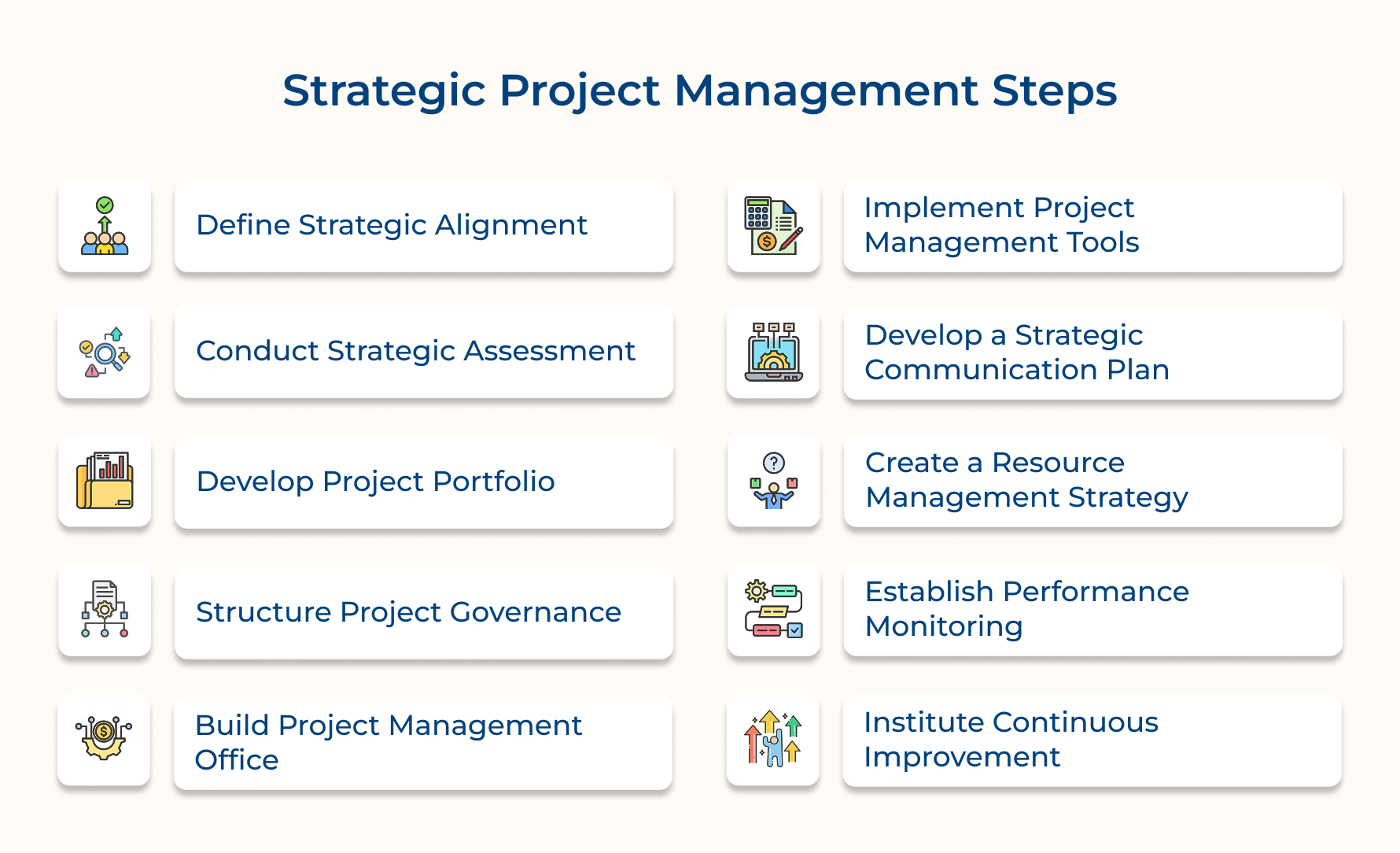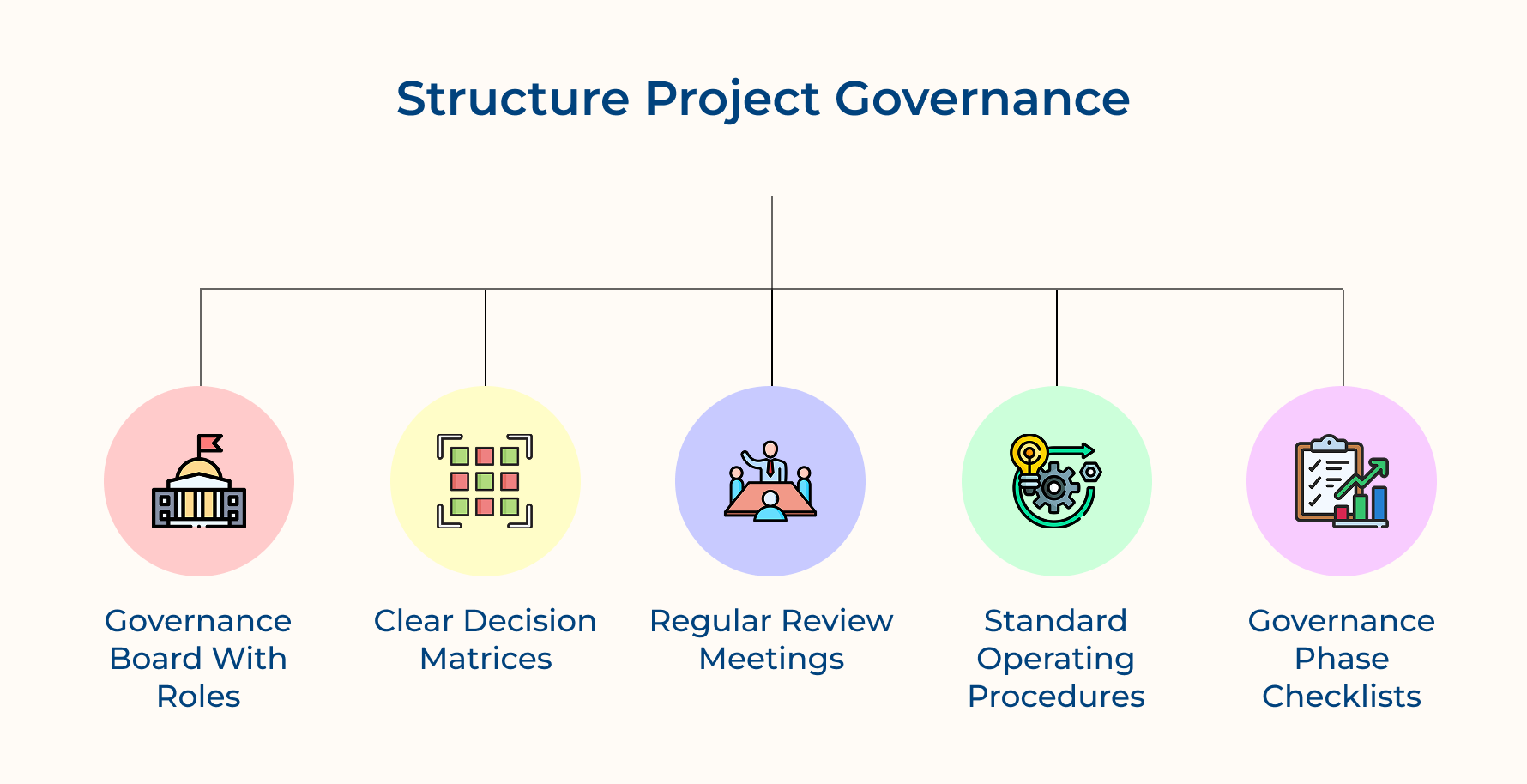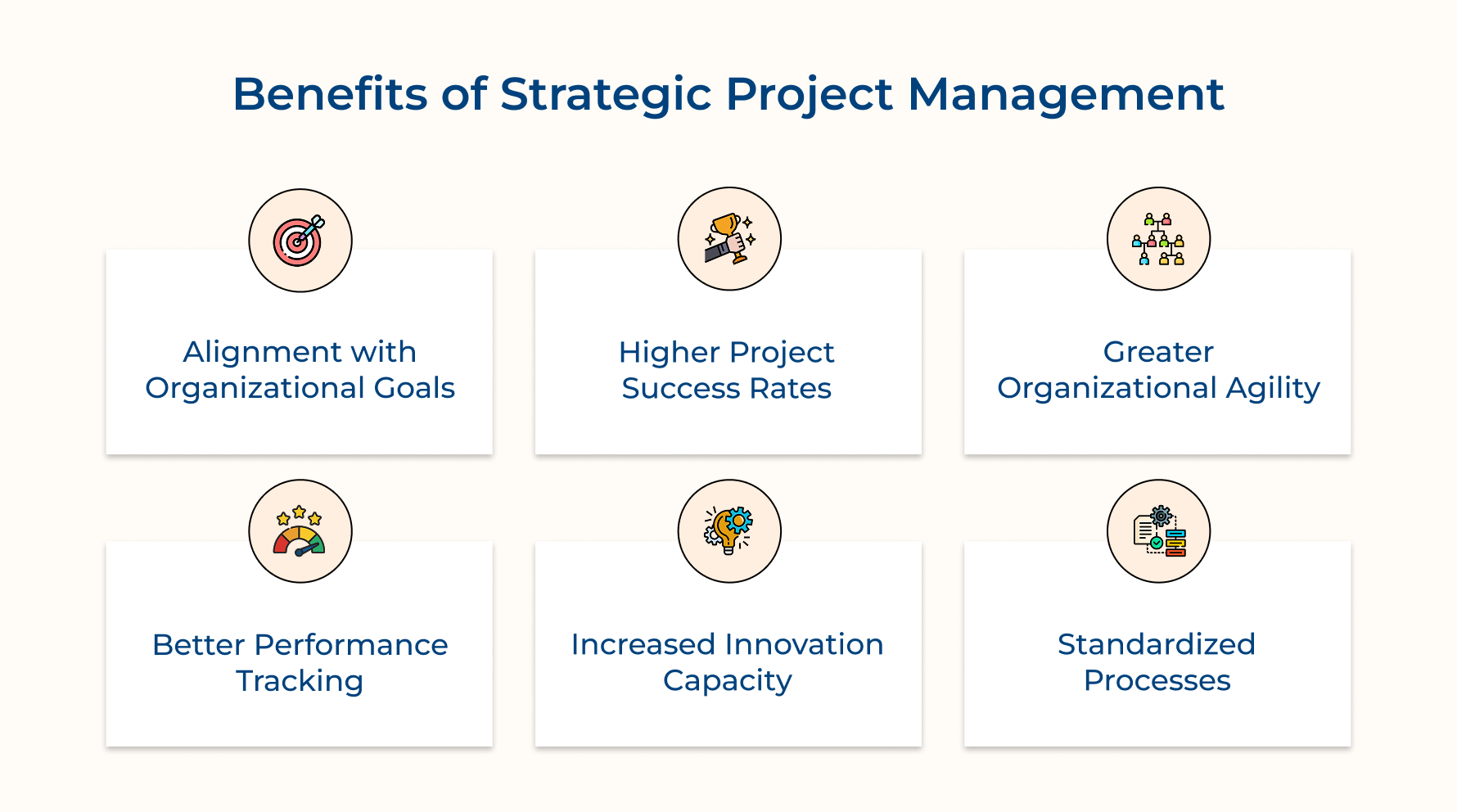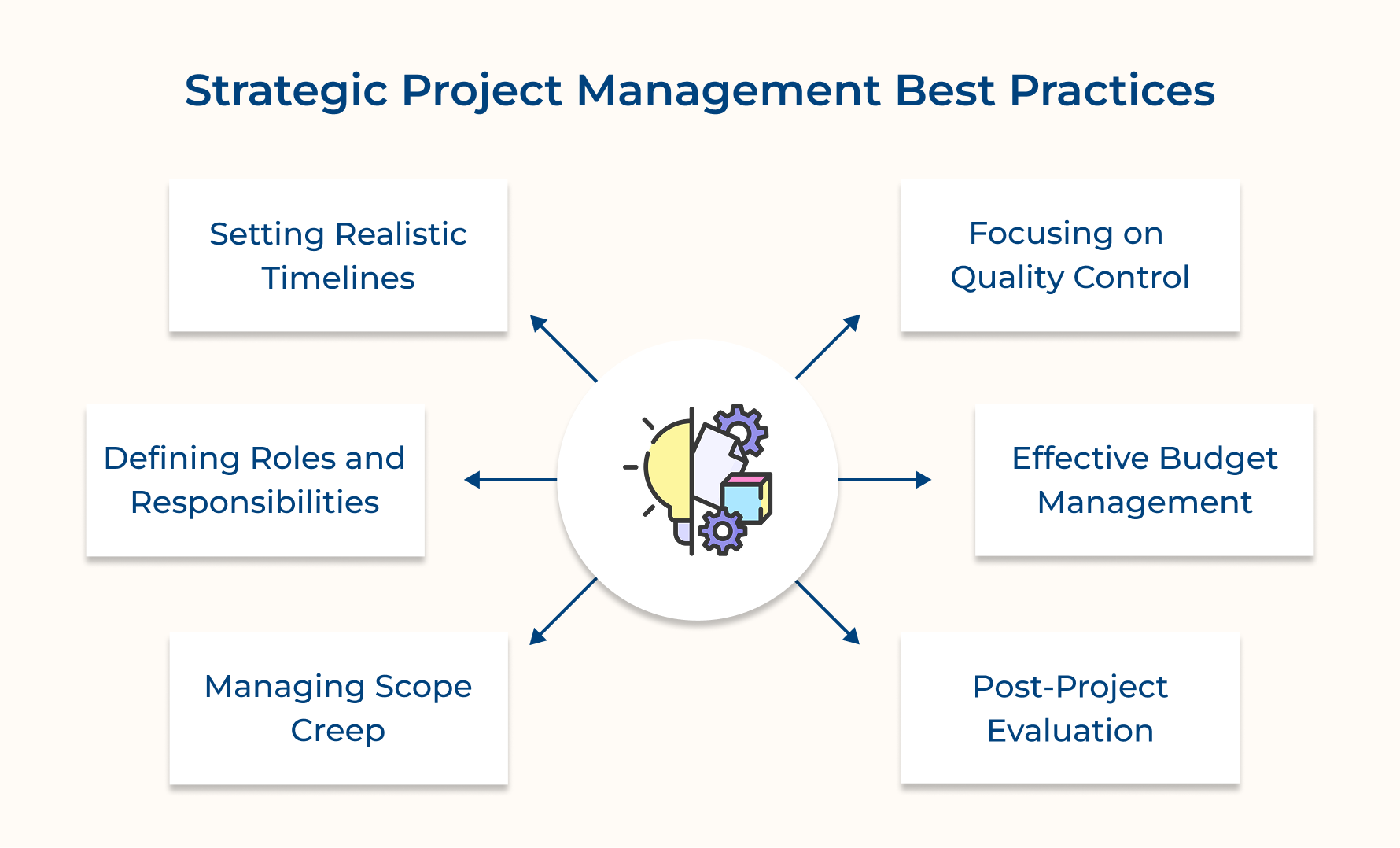Top 10 Steps to Implementing Strategic Project Management

Key Highlights:
- Strategic project management keeps projects aligned with business goals, so every effort drives real results and long-term success.
- Effective resource management helps teams stay on track by balancing workloads, avoiding bottlenecks, and making the best use of resources.
- It also encourages learning from past projects and constantly improving for better efficiency.
Many organizations struggle to keep projects aligned with their big-picture goals, which can lead to wasted time, budget overruns, and disappointing results.
When projects don’t align, companies miss opportunities, spend more than they should, and lose value—hurting their competitive edge. That’s where strategic project management comes in. It helps teams focus on the right initiatives, use resources wisely, and manage risks effectively.
Let’s learn how to implement these strategies as well as how it benefits in the long run.
What is Strategic Project Management?
Strategic project management focuses on aligning projects with business goals. Every project decision is evaluated based on its impact. The goal is to support growth and maintain a competitive edge. The practice involves selecting, prioritizing, and executing projects that directly support the organization’s mission as well as strategic initiatives.
Efficient resource allocation emerges through proper strategic management, reducing waste on non-essential projects and maximizing return on investment. Strong links between projects and strategic goals allow organizations to adapt to market changes, maintain competitive advantage, while achieving sustainable growth. Clear strategic alignment helps stakeholders understand the broader purpose of projects and their impact on organizational success, building better buy-in as well as support.
Key objectives:
- Portfolio optimization: Ensure all projects in the portfolio align with strategic goals and deliver maximum value to the organization.
- Resource efficiency: Utilize resources effectively across projects based on strategic priorities and organizational capabilities.
- Strategic alignment: Maintain continuous alignment between project outcomes and organizational strategic objectives throughout the project lifecycle.
- Value creation: Generate sustainable competitive advantage through successful project delivery that contributes to strategic goals and stakeholder value.
How to Implement Strategic Project Management in 10 Steps
Want to make sure your projects drive real business success? Follow these 10 steps to align your projects with your company’s big-picture goals.
1. Define Strategic Alignment
Keeping projects aligned with business goals ensures they add real value. Here’s how to make sure every project stays on track:
Define Strategic Alignment
- Make sure all project activities support company goals.
- Map project outcomes to your business strategy.
- Connect deliverables to the company’s long-term vision.
Why Alignment Matters
- Prevents wasting resources on low-impact projects.
- Ensures every project drives business success.
- Keeps teams focused on what truly matters.
How to Maintain Alignment
- Use a strategic alignment matrix → Match each project to specific goals.
- Develop clear project charters → Clearly state how deliverables support objectives.
- Conduct regular reviews → Check alignment at every phase.
- Measure strategic contribution → Use scorecards to track impact.
Pro tips:
- Create visual strategy maps linking project outcomes to organizational objectives, using tools like balanced scorecards or OKR frameworks.
- Establish quarterly strategic alignment reviews with stakeholders to ensure projects remain aligned with evolving business goals.
2. Conduct Strategic Assessment
Before diving into a project, it’s essential to evaluate your organization’s ability to execute it successfully. Here’s how:
What It Involves
- Analyze internal strengths and weaknesses.
- Identify external opportunities and threats.
- Assess resource capacity and potential risks.
Why It Matters
- Prevents taking on projects beyond your capabilities.
- Helps with realistic scoping and resource planning.
- Identifies roadblocks early to avoid setbacks.
How to Conduct a Strategic Assessment
- Host SWOT analysis workshops → Get insights from key stakeholders.
- Use capability assessment tools → Evaluate team capacity and skills.
- Create risk matrices → Identify and prioritize potential risks.
- Develop readiness checklists → Ensure all project aspects are prepared.
- Document findings → Compile insights in a detailed assessment report.
Pro tips:
- Use standardized assessment templates and scoring systems to ensure consistent evaluation across different project aspects.
- Include cross-functional teams in assessment workshops to gather diverse perspectives and identify hidden challenges.
3. Develop Project Portfolio
Handling multiple projects at once? Portfolio management helps you prioritize, allocate resources wisely, and keep everything aligned with your company’s goals. It’s all about balancing risks, returns, and resources across projects to ensure efficiency as well as success.
To make it work, use portfolio management software to track projects in one place. Set up a clear prioritization framework based on strategic value and resource needs.
Regularly review your portfolio to make adjustments, and use balancing techniques to distribute resources effectively across different types of projects. This way, you stay focused on what truly matters and get the best results.
Pro tips:
- Develop a weighted scoring model for project selection that includes strategic alignment, ROI, risk, and resource availability.
- Implement quarterly portfolio rebalancing sessions to adjust project priorities based on changing business conditions.
4. Structure Project Governance
Project governance ensures clear decision-making, accountability, and oversight, helping teams manage projects efficiently. A well-structured governance framework reduces risks, maintains quality, and ensures consistency across all projects.
Here’s how to establish effective project governance:
- Establish a governance board with defined roles and responsibilities.
- Create decision-making matrices to clarify authority levels.
- Implement regular governance meetings and reviews for oversight.
- Develop standard operating procedures for project management.
- Use governance checklists to track key project phases and ensure compliance.
Pro tips:
- Create a RACI matrix for all project governance roles to clearly define responsibilities and decision rights.
- Establish monthly governance board meetings with standardized reporting templates and decision logs.
5. Build Project Management Office (PMO)
A centralized department that standardizes project-related governance processes and facilitates resource sharing across projects. The PMO acts as the central point for project methodology, tools, and best practices within the organization.
A PMO provides consistency in project execution, supports project managers, and ensures standardization of processes. It serves as a center of excellence for project management, helping to improve project success rates and maintain organizational standards.
Start with defining the PMO charter and scope. Implement standard project management methodologies. Create templates and tools for project managers while establishing support services for projects.
Pro tips:
- Begin with a supportive PMO model focused on enabling project success rather than strict control.
- Create a PMO toolkit with templates, checklists, and guidelines that make it easier for teams to follow standards.
6. Implement Project Management Tools
The right tools make project planning, execution, and tracking easier. They improve efficiency, enhance collaboration, and provide real-time visibility into project progress.
- Identify tools that match your organization’s needs and capabilities.
- Implement in phases, starting with core features.
- Provide thorough training to ensure smooth adoption.
- Create standardized templates and workflows within the tools.
- Regularly review tool usage and effectiveness for continuous improvement.
Pro tips:
- Start with a pilot group to test and refine tool implementation before rolling out organization-wide.
- Create video tutorials and quick reference guides for common tool operations to support user adoption.
7. Develop a Strategic Communication Plan
Good communication keeps everyone on the same page, prevents misunderstandings, and ensures smooth project progress. It helps align stakeholders, manage expectations, and build trust.
- Create a stakeholder communication matrix to define who needs what information.
- Establish regular communication rhythms, like meetings or status updates.
- Develop templates for reports, emails, and other key messages.
- Set up clear feedback channels to encourage open dialogue.
- Monitor communication effectiveness and adjust as needed.
Pro tips:
- Create a stakeholder communication matrix that maps message types to audience needs and preferred channels.
- Schedule monthly communication audits to ensure messages are reaching intended audiences effectively.
8. Create a Resource Management Strategy
Ever had a project stall because key team members were overloaded or materials weren’t available on time? That’s where resource management comes in—it ensures the right people, budget, and materials are in place to keep things moving.
Imagine your team is juggling multiple projects. Without proper planning, one project might have too many resources while another struggles to stay afloat.
Avoid it by using resource management software to track allocations, plan workloads effectively, and match team members to tasks based on their skills. Set up a clear process for requesting and approving resources. Regularly check if adjustments are needed to keep everything running smoothly.
Pro tips:
- Create a centralized resource pool with clear visibility of all resource commitments and availability.
- Implement weekly resource utilization reviews to identify and address potential capacity issues early.
9. Establish Performance Monitoring
Tracking project performance helps identify issues early, keeps everything on schedule, and ensures projects deliver real value. A solid monitoring system improves accountability and drives continuous improvement.
Define Key Performance Indicators (KPIs)
- Set clear metrics to measure success.
- Align KPIs with business goals and project objectives.
Create Performance Dashboards
- Use visual tools to track progress in real-time.
- Make dashboards accessible to key stakeholders.
Implement Regular Review Cycles
- Schedule performance check-ins at key milestones.
- Use data to make informed decisions and adjustments.
Establish Corrective Action Procedures
- Identify issues early and take proactive steps.
- Assign responsibility for resolving performance gaps.
Leverage Automation for Monitoring
- Use project management software for real-time tracking.
- Automate reporting to keep stakeholders informed.
Teams can stay ahead of challenges, optimize resources, and ensure successful project outcomes by consistently monitoring performance
Pro tips:
- Develop a balanced scorecard of leading and lagging indicators to provide comprehensive performance insights.
- Schedule bi-weekly performance review meetings with project teams to address issues promptly.
10. Institute Continuous Improvement
Great project management isn’t just about getting things done—it’s about getting better over time. Continuous improvement helps teams learn from past experiences, avoid repeated mistakes, and refine processes for better efficiency.
- Conduct lessons learned sessions → Gather insights after each project.
- Implement feedback collection systems → Encourage teams to share what worked and what didn’t.
- Analyze performance trends → Identify patterns and areas for improvement.
- Create improvement action plans → Turn lessons into concrete changes.
- Monitor implementation → Ensure improvements are put into practice.
- Share best practices → Spread knowledge across teams for organization-wide growth.
Pro tips:
- Create a lessons-learned database that’s easily searchable and accessible to all project teams.
- Schedule quarterly improvement workshops to review and implement suggested process enhancements.
Benefits of Strategic Project Management
Strategic project management goes beyond just completing tasks and aligns projects with business goals to drive long-term success. Here’s how it benefits organizations.
Clear Alignment with Organizational Goals
Aligning project objectives with broader organizational goals guarantees that each project contributes to long-term success. Ensuring projects add real value helps drive business growth and reinforces the overall strategic vision of the company.
Higher Project Success Rates
Structured planning and execution significantly increase project success rates. Proven methodologies and adaptive planning minimize delays, cost overruns, as well as scope creep, leading to more successful outcomes.
Greater Organizational Agility
Organizations maintaining strategic project oversight respond quickly to market changes. Rapid reprioritization and resource reallocation become possible when business needs shift, maintaining competitive advantage.
Better Performance Tracking
Strategic project management establishes comprehensive monitoring and measurement systems. Regular tracking of KPIs ensures projects maintain alignment with strategic objectives and deliver expected benefits on schedule.
Increased Innovation Capacity
Structured approaches to managing change and innovation emerge through strategic project management. Organizations can evaluate, prioritize, and execute innovative initiatives while maintaining effective risk management practices.
Standardized Processes
Consistent methodologies and processes across projects improve organizational efficiency. Standard practices reduce errors while making project performance measurement and comparison straightforward across departments.
Best Practices for Effective Strategic Project Management
Effective strategic project management ensures projects align with organizational goals, optimize resources, and drive growth. Here are some best practices to follow:
Setting Realistic Timelines
Creating achievable timelines ensures your project stays on track without rushing. Unrealistic deadlines often lead to stress and lower-quality work. Practical time frames allow the team to focus on doing their best and delivering top-notch results.
Defining Roles and Responsibilities
Clearly outlining who does what prevents confusion and ensures everyone knows their responsibilities. When team members understand their tasks, it reduces overlap and encourages ownership, making the whole process run smoother.
Managing Scope Creep
Scope creep happens when project goals expand without proper approval, which can derail progress. Keep things in check with clear goals and a structured change management process to stay focused as well as on track.
Focusing on Quality Control
Consistent quality checks throughout the project ensure high standards are maintained and prevent costly mistakes. By building in quality control at every stage, you make sure deliverables meet expectations and adhere to industry standards.
Effective Budget Management
Staying on top of the project budget is crucial to avoid financial stress. Regularly track expenses, manage costs, and make adjustments as needed to keep everything within budget as well as prevent overspending.
Post-Project Evaluation
Conducting a post-project evaluation provides valuable insights into what worked well and areas for improvement. Analyzing outcomes helps identify best practices, lessons learned, and opportunities for future projects, contributing to continuous improvement in project management practices.
Strategic Project Management: A Foundation for Success
Strategic project management drives project success and ensures alignment with organizational goals. It allows for better resource allocation and effective risk management, leading to smoother project execution along with greater efficiency.
Clear communication and well-informed decision-making support team collaboration, helping projects stay on track as well as achieve their objectives. These practices ensure that resources are used effectively and that all team members work towards common goals.
Adopting strategic project management practices improves project success rates, increases stakeholder satisfaction, and provides a competitive advantage. Completing projects on time and within budget helps support long-term growth.
Limit time — not creativity
Everything you need for customer support, marketing & sales.
Neeti Singh is a passionate content writer at Kooper, where he transforms complex concepts into clear, engaging and actionable content. With a keen eye for detail and a love for technology, Tushar Joshi crafts blog posts, guides and articles that help readers navigate the fast-evolving world of software solutions.



